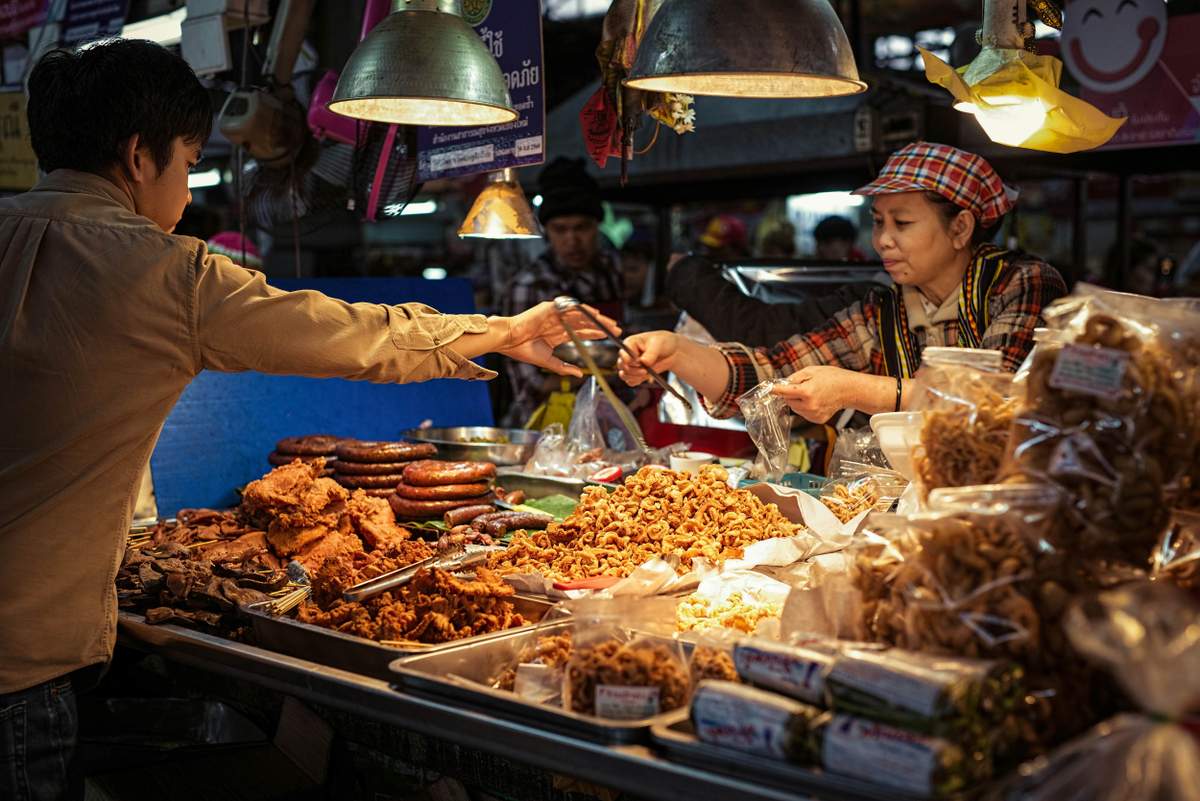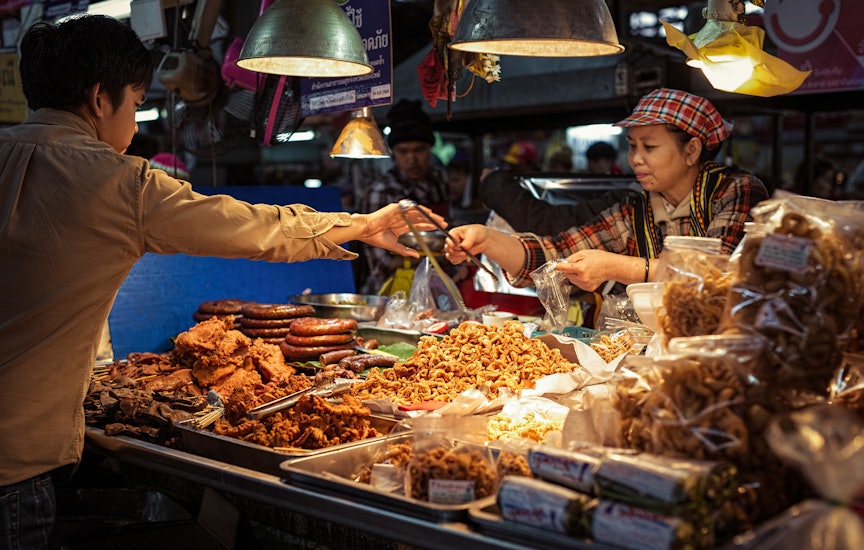
Shopping in Chiang Mai: your essential guide to the city's night markets

Jul 31, 2018 • 5 min read

Handicrafts, textiles and jewellery, just some of the delights on sale in Chiang Mai. Stuart Dee / Getty Images
If you're planning to shop in Thailand, Chiang Mai is the place to bring an empty suitcase. The Rose of the North's reputation for shopping extends back hundreds of years, thanks to its location close to historic trade routes connecting modern-day Myanmar, Laos and China. In the past, passing caravans traded silks, wood, tobacco and opium. Today, arts and crafts, jewellery and clothing draw bargain hunters to this northern Thai city.
Here's everything you need to know to get the most out of Thailand's shopping capital: unmissable night markets, the best bazaars, and street food certain to boost your bartering skills.
What to buy in Chiang Mai
Back in the 15th century, Chinese Muslim traders from Yunnan province passed through the mountains in horse-drawn caravans laden with gold, cotton, ivory, tobacco and edible bird nests. Silks, tea and dried fruits were just some of their exports. Today, Chiang Mai has built a name for itself as a cultural centre, with many local artisans finding artistic expression through handicrafts, silverware and fashion that blend ancient traditions with contemporary techniques.
Lacquerware is an especially good buy in Chiang Mai. The region has a long tradition of producing distinctive gold-on-black lacquerware pieces including bowls, decorative boxes and bracelets. Other local specialities include handmade paper umbrellas, silks and ceramics, particularly the local celadon green glaze. You'll also find embroidered bags and other handmade goods produced by local hill tribes. There is also no shortage of designer knock-offs, cheap watches, cheesy souvenirs and sunglasses, with much of the same gear flogged by different vendors around town.

Sunset shopping at the weekend's Walking Street markets
For the complete Chiang Mai shopping experience, be sure to stay in the city over the weekend, when the Saturday and Sunday Walking Street markets take place.
The smaller, less busy of the two is Saturday Walking Street market along Th Wualai, which closes to traffic. It starts shortly after 4pm and vendors start packing up at about 10pm. Ambling through this atmospheric neighbourhood, passing traditional silver shops and old ladies wrapped in Thai silk, is the perfect way to drink in this market's timeless feel.
For the Sunday Walking Street market, the street closes to traffic from Tha Phae Gate down the full length of Th Ratchadamnoen from 4pm until around midnight. The street is packed with stalls selling locally hand-crafted goods made from paper, silk, wood and ceramics. Arrive early to watch vendors empty their swollen packs and neatly arrange their product displays. The first sale of the night is sometimes followed by a small ritual or prayer, in the hope that more business will follow.
Many products are handmade in and around Chiang Mai, including cotton scarves, leather sandals and wood carvings – if you're eager to buy a local souvenir, don't be shy to ask where items were made. Here Chiang Mai also expresses its hippie side with plenty of elaborate accessories, cotton T-shirts and ‘save the planet’ canvas tote bags. The market comes alive after dark with street entertainers including musicians and puppeteers. And if all the shopping leaves you with aching feet, you can always stop for a massage paired with people-watching.
Haggling heaven at the Night Bazaar
While the Walking Street markets are better for artisan goods, bargain hunters will love Chiang Mai’s Night Bazaar. Every evening, as offices shut down and darkness falls, the Night Bazaar lights up. Between sunset and midnight you'll find hawkers, vendors and shoppers jamming the footpath of Th Chang Khlan, from Th Tha Phae past Th Loi Kroh (the area immediately around the market buildings).

If you’re browsing for knock-off designer labels and souvenirs – and you're undeterred by crowds or cheap trinkets – then this is the place to go. Within the dedicated shopping buildings, the antique and handicraft stores are well worth a look. Across the street is the Galare Night Bazaar selling upmarket clothes and home décor. Nearby Anusarn Market feels less claustrophobic, with tables of vendors selling knitted caps, carved soaps and other cottage-industry goods. The quality isn’t always top notch and the prices aren’t especially tempting, but the market’s allure lies in the sheer variety of goods on offer.
To refuel, stop at the food courts or various restaurants in Galare or Anusarn, or check out the newer Ploen Ruedee Market, which features a collection of stalls serving international dishes plus live music and performances for ambiance.
Smaller night markets in Chiang Mai
While Chiang Mai's larger night markets may be more well-known, the city is also home to a number of other markets that pop up as the sun goes down.
Temporary stalls and food carts line the streets leading into Talat Warorot every evening as the regular daytime shops close. Though the cheap gadgets, homewares and clothing may not be of interest, the seemingly boundless food options dominate the scene. Squeeze through the narrow paths and pick up a variety of Thai snacks with the locals.
Another evening food spot, Kad Manee on Th Thippanet, is also open every evening with tented vendors selling anything from takeaway snacks to full meals. The market isn't as crowded as many of the other night markets and has more open space, which makes it easier to manage with kids or for those with mobility restrictions.
For those looking for a uniquely local experience, make your way toward Chiang Mai University where, near the main campus entrance, you'll find the Chiang Mai Complex. Wander through the latest Thai fashions, accessories, electronics and university dorm room decor, then head toward the back of the market where there are, unsurprisingly, eating options aplenty. Thai-style barbecue and hotpot that you cook at the table are particularly popular here.
No matter which market takes your fancy, you're never too far from a delicious bowl of soup or curry, so follow your nose. After all that browsing and bartering, a street food feast makes a fine reward.
This article was first published by Lonely Planet in July 2010, and updated by Alana Morgan in July 2018.















